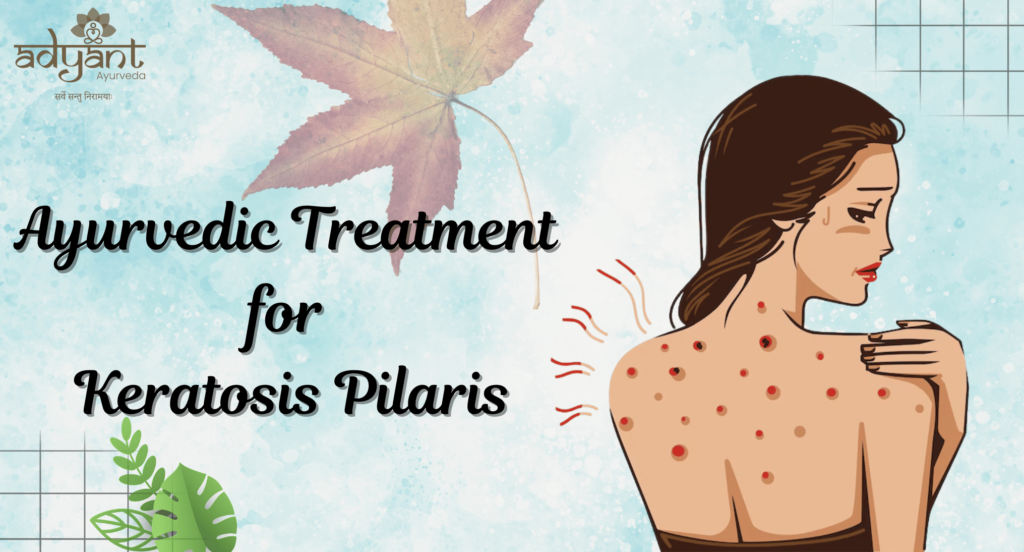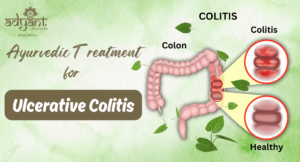
Ayurvedic Treatment for Keratosis Pilaris: Keratosis Pilaris (KP) is a common skin condition characterized by small, rough bumps on the skin, often resembling goosebumps or chicken skin. In Ayurveda, Keratosis Pilaris is viewed as an imbalance in the body’s doshas, particularly Vata and Kapha. Adyant Ayurveda offers holistic approaches to treating Keratosis Pilaris, focusing on natural remedies and lifestyle modifications.
In this blog, we will delve into the Ayurvedic perspective on Keratosis Pilaris, including causes, symptoms, and effective treatments.
Get a Free Consultation By Downloading Our App “AyurCare“
Understanding Ayurvedic Treatment for Keratosis Pilaris
Keratosis Pilaris occurs when keratin, a protein that protects the skin, clogs hair follicles, leading to the formation of small bumps. Factors such as dry skin, genetic predisposition, hormonal changes, and dietary imbalances can contribute to Keratosis Pilaris. In Ayurveda, this condition is often associated with Vata and Kapha imbalances, leading to dryness, roughness, and inflammation of the skin.
You May Also Like: Ayurveda Doshas
Ayurvedic Treatment for Keratosis Pilaris: Causes
- Dry Skin: Lack of moisture in the skin can contribute to the buildup of keratin and the development of Keratosis Pilaris bumps.
- Genetic Factors: Keratosis Pilaris often runs in families, indicating a genetic predisposition to the condition.
- Hormonal Changes: Hormonal fluctuations, especially during puberty or pregnancy, can exacerbate Keratosis Pilaris symptoms.
- Dietary Imbalances: Consuming excessive dry, cold, or processed foods can aggravate Vata dosha and contribute to skin dryness and roughness.
- Environmental Factors: Exposure to harsh weather conditions, chemicals, or allergens can trigger or worsen Keratosis Pilaris symptoms.
Ayurvedic Treatment for Keratosis Pilaris: Symptoms
- Small Bumps: The most common symptom of Keratosis Pilaris is the presence of small, rough bumps on the skin, often on the arms, thighs, cheeks, or buttocks.
- Redness & Inflammation: The affected areas may appear red, inflamed, or irritated, especially after scratching or friction.
- Dryness & Itching: KP-affected skin tends to be dry, itchy, and prone to flakiness or scaling.
- Appearance of “Chicken Skin”: Keratosis Pilaris bumps can resemble goosebumps or the skin texture of a plucked chicken, leading to cosmetic concerns.
Read Also: Ayurvedic Skin Care Treatment
Ayurvedic Home Remedies for Keratosis Pilaris:
- Oil Massage: Ayurvedic Treatment for Keratosis Pilaris regularly massaging the affected areas with warm sesame oil or coconut oil can soften the skin, improve circulation, and reduce dryness.
- Herbal Pastes: Applying herbal pastes made from Neem, Turmeric, and Aloe Vera can soothe inflammation, reduce itching, and promote skin repair.
- Nutritional Supplements: Consuming Ayurvedic supplements rich in Omega-3 fatty acids, Vitamin A, and antioxidants can support skin health and reduce Keratosis Pilaris symptoms.
Diet and Lifestyle Adaptations for Managing Keratosis Pilaris:
Keratosis Pilaris (KP) can be influenced by dietary choices and lifestyle habits. Adopting specific diet and lifestyle adaptations can complement Ayurvedic treatments and promote healthier skin. Here are some Dietary and Lifestyle recommendations:
Ayurvedic Treatment for Keratosis Pilaris: Dietary Recommendations
- Include Moisturizing Foods: Consume foods that are naturally hydrating and nourishing for the skin. Incorporate foods rich in essential fatty acids, such as avocado, flaxseeds, and walnuts.
- Stay Hydrated: Drink an adequate amount of water throughout the day to maintain skin hydration and support overall health.
- Emphasize Antioxidants: Ayurvedic Treatment for Keratosis Pilaris involves consuming a variety of fruits and vegetables high in antioxidants, such as berries, spinach, kale, and bell peppers, to protect the skin from oxidative stress.
- Avoid Trigger Foods: Identify and avoid foods that may exacerbate Keratosis Pilaris symptoms, such as dairy products, processed foods, fried foods, and sugary snacks.
Read Also: Get Healthy & Natural Glowing Skin with Ayurveda
Lifestyle Modifications:
- Regular Exercise: Engage in regular physical activity to improve circulation, support detoxification, and promote overall well-being.
- Stress Management: Ayurvedic Treatment for Keratosis Pilaris involves practicing stress-reducing techniques such as yoga, meditation, deep breathing exercises, and mindfulness to manage stress levels and prevent flare-ups.
- Gentle Skincare Routine: Use gentle skincare products suitable for sensitive skin. Avoid harsh exfoliants or abrasive treatments that can irritate Keratosis Pilaris-affected areas.
- Sun Protection: Protect your skin from excessive sun exposure by wearing sunscreen, and protective clothing, and seeking shade during peak hours.
- Avoid Hot Showers: Opt for lukewarm showers instead of hot water, as hot water can strip the skin of natural oils and exacerbate dryness.
Ayurvedic Supplements:
Consider incorporating Ayurvedic supplements or herbal formulations recommended by your Ayurvedic practitioner to support skin health, balance doshas, and reduce inflammation internally.
By making these diet and lifestyle adaptations, individuals can complement Ayurvedic treatment for Keratosis Pilaris, promote skin hydration, reduce inflammation, and improve overall skin health. It’s essential to consult with an Ayurvedic doctor or healthcare professional before making significant dietary or lifestyle changes to ensure they are appropriate for your individual needs and health condition.
Also Know: Best Ayurvedic Doctor for Skin in Bangalore
Ayurvedic Diagnosis of Keratosis Pilaris (KP):
Ayurvedic treatment for Keratosis Pilaris involves assessing the individual’s dosha imbalance, skin type (Vata, Pitta, Kapha), digestive health, and lifestyle factors. Pulse diagnosis (Nadi Pariksha) and examination of skin texture, color, and moisture levels are used to determine the underlying causes of Keratosis Pilaris.
Ayurvedic Treatment Approaches:
- Balancing Doshas: Ayurvedic treatment for Keratosis Pilaris focuses on balancing Vata and Kapha doshas through dietary changes, herbal remedies, and lifestyle modifications.
- Herbal Remedies: Adyant Ayurveda offers herbal formulations that nourish and hydrate the skin, reduce inflammation, and improve skin texture. Ingredients like Neem, Aloe Vera, Turmeric, and Manjistha are commonly used in these formulations.
- Dietary Recommendations: Patients are advised to follow a skin-friendly diet, including warm, moist, and nourishing foods. Incorporating ghee, coconut oil, fresh fruits, vegetables, and herbal teas can support skin health.
- Lifestyle Modifications: Ayurveda emphasizes the importance of regular oil massage (Abhyanga), adequate hydration, stress management, and proper skincare routines to alleviate Keratosis Pilaris symptoms.
- Panchakarma Therapies: In severe or chronic cases of Keratosis Pilaris, Panchakarma therapies such as Virechana (therapeutic purgation) or Nasya (nasal administration of medicated oils) may be recommended to detoxify the body and promote skin healing.
Read Also: What is Panchakarma
Preventive Measures & Skincare Tips:
- Gentle Exfoliation: Avoid harsh scrubbing or exfoliation, as it can worsen Keratosis Pilaris . Use gentle exfoliants like oatmeal or chickpea flour to remove dead skin cells.
- Moisturization: Ayurvedic Treatment for Keratosis Pilaris involves skin moisturizing. Keep the skin well-hydrated by using moisturizers or herbal oils suitable for your skin type. Avoid products with harsh chemicals or fragrances.
- Avoiding Triggers: Identify and avoid triggers that exacerbate Keratosis Pilaris symptoms, such as extreme weather conditions, hot showers, or irritating fabrics.
- Sun Protection: Protect KP-affected areas from excessive sun exposure by using sunscreen or wearing protective clothing.
- Stress Management: Practice stress-reducing techniques like yoga, meditation, and deep breathing exercises to promote overall well-being and skin health.
Know Also: Best Ayurvedic Clinic in Bangalore
Ayurvedic Treatment for Keratosis Pilaris: Conclusion
Keratosis Pilaris can be effectively managed and treated through Ayurvedic principles of holistic healing, natural remedies, and lifestyle adjustments. Adyant Ayurveda offers comprehensive solutions for Keratosis Pilaris, addressing the root causes, improving skin health, and enhancing overall well-being. By incorporating Ayurvedic treatments, herbal remedies, and preventive measures, individuals can experience relief from Keratosis Pilaris symptoms, achieve smoother skin, and start a healthier lifestyle.
FAQs about Keratosis Pilaris Ayurvedic Treatment:
Ques: What is Keratosis Pilaris Ayurvedic Treatment?
Ans: Keratosis Pilaris Ayurvedic Treatment involves a holistic approach to managing Keratosis Pilaris through natural remedies, dietary adjustments, lifestyle modifications, and herbal therapies based on Ayurvedic principles.
Ques: How does Ayurveda diagnose and treat Keratosis Pilaris?
Ans: Ayurvedic diagnosis of Keratosis Pilaris involves assessing dosha imbalances, skin type, digestive health, and lifestyle factors. Treatment includes balancing doshas, using herbal remedies, dietary recommendations, lifestyle modifications, and Panchakarma therapies if needed.
Ques: What are the key Ayurvedic remedies for Keratosis Pilaris?
Ans: Key Ayurvedic remedies for Keratosis Pilaris include herbal formulations with ingredients like Neem, Aloe Vera, Turmeric, and Manjistha, and dietary recommendations focused on balancing doshas and promoting skin health.
Ques: Are Ayurvedic treatments safe for managing Keratosis Pilaris?
Ans: Ayurvedic treatments for Keratosis Pilaris are generally safe when prescribed and administered by qualified Ayurvedic practitioners. They focus on natural healing and minimizing side effects.
Ques: How long does it take to see results with Ayurvedic treatment for Keratosis Pilaris?
Ans: The time taken to see results with Ayurvedic treatment for Keratosis Pilaris varies depending on the severity of the condition, individual response to treatment, adherence to dietary and lifestyle recommendations, and the specific therapies used.






